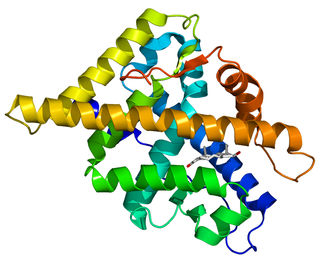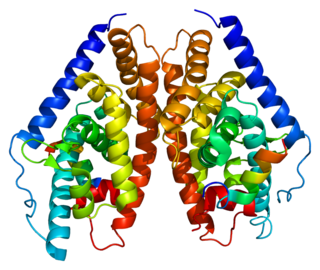
The androgen receptor (AR), also known as NR3C4, is a type of nuclear receptor that is activated by binding any of the androgenic hormones, including testosterone and dihydrotestosterone, in the cytoplasm and then translocating into the nucleus. The androgen receptor is most closely related to the progesterone receptor, and progestins in higher dosages can block the androgen receptor.

The constitutive androstane receptor (CAR) also known as nuclear receptor subfamily 1, group I, member 3 is a protein that in humans is encoded by the NR1I3 gene. CAR is a member of the nuclear receptor superfamily and along with pregnane X receptor (PXR) functions as a sensor of endobiotic and xenobiotic substances. In response, expression of proteins responsible for the metabolism and excretion of these substances is upregulated. Hence, CAR and PXR play a major role in the detoxification of foreign substances such as drugs.

The nuclear receptor coactivator 1 (NCOA1), also called steroid receptor coactivator-1 (SRC-1), is a transcriptional coregulatory protein that contains several nuclear receptor–interacting domains and possesses intrinsic histone acetyltransferase activity. It is encoded by the gene NCOA1.

The Rev-Erb proteins are members of the nuclear receptor (NR) superfamily of intracellular transcription factors and key regulatory components of the circadian clock. There are two forms of the receptor, Rev-Erb alpha and Rev-Erb beta, which are each encoded by a separate gene .

The nuclear receptor 4A1 also known as Nur77, TR3, and NGFI-B is a protein that in humans is encoded by the NR4A1 gene.

The small heterodimer partner (SHP) also known as NR0B2 is a protein that in humans is encoded by the NR0B2 gene. SHP is a member of the nuclear receptor family of intracellular transcription factors. SHP is unusual for a nuclear receptor in that it lacks a DNA binding domain. Therefore, it is technically neither a transcription factor nor nuclear receptor but nevertheless it is still classified as such due to relatively high sequence homology with other nuclear receptor family members.

Rev-Erb alpha (Rev-Erbɑ), also known as nuclear receptor subfamily 1 group D member 1 (NR1D1), is one of two Rev-Erb proteins in the nuclear receptor (NR) family of intracellular transcription factors. In humans, REV-ERBɑ is encoded by the NR1D1 gene, which is highly conserved across animal species.

Rev-Erb beta (Rev-Erbβ), also known as nuclear receptor subfamily 1 group D member 2 (NR1D2), is a member of the Rev-Erb protein family. Rev-Erbβ, like Rev-Erbα, belongs to the nuclear receptor superfamily of transcription factors and can modulate gene expression through binding to gene promoters. Together with Rev-Erbα, Rev-Erbβ functions as a major regulator of the circadian clock. These two proteins are partially redundant. Current research suggests that Rev-Erbβ is less important in maintaining the circadian clock than Rev-Erbα; knock-out studies of Rev-Erbα result in significant circadian disruption but the same has not been found with Rev-Erbβ. Rev-Erbβ compensation for Rev-Erbα varies across tissues, and further research is needed to elucidate the separate role of Rev-Erbβ.

Nuclear receptor-interacting protein 1 (NRIP1) also known as receptor-interacting protein 140 (RIP140) is a protein that in humans is encoded by the NRIP1 gene.

COUP-TF1 also known as NR2F1 is a protein that in humans is encoded by the NR2F1 gene. This protein is a member of nuclear hormone receptor family of steroid hormone receptors.

COUP-TFII, also known as NR2F2 is a protein that in humans is encoded by the NR2F2 gene. The COUP acronym stands for chicken ovalbumin upstream promoter.

Thyroid hormone receptor alpha (TR-alpha) also known as nuclear receptor subfamily 1, group A, member 1 (NR1A1), is a nuclear receptor protein that in humans is encoded by the THRA gene.

Thyroid hormone receptor beta (TR-beta) also known as nuclear receptor subfamily 1, group A, member 2 (NR1A2), is a nuclear receptor protein that in humans is encoded by the THRB gene.

Liver X receptor beta (LXR-β) is a member of the nuclear receptor family of transcription factors. LXR-β is encoded by the NR1H2 gene.

Mediator of RNA polymerase II transcription subunit 1 also known as DRIP205 or Trap220 is a subunit of the Mediator complex and is a protein that in humans is encoded by the MED1 gene. MED1 functions as a nuclear receptor coactivator.

Nuclear receptor coactivator 6 is a protein that in humans is encoded by the NCOA6 gene.

Thyroid receptor-interacting protein 6 is a protein that in humans is encoded by the TRIP6 gene.

Nuclear receptor coactivator 5 (NCOA5), also known as coactivator independent of AF-2 function (CIA), is a protein that in humans is encoded by the NCOA5 gene.

Activating signal cointegrator 1 is a protein that in humans is encoded by the TRIP4 gene.
Nuclear receptor coregulators are a class of transcription coregulators that have been shown to be involved in any aspect of signaling by any member of the nuclear receptor superfamily. A comprehensive database of coregulators for nuclear receptors and other transcription factors was previously maintained at the Nuclear Receptor Signaling Atlas website which has since been replaced by the Signaling Pathways Project website.























